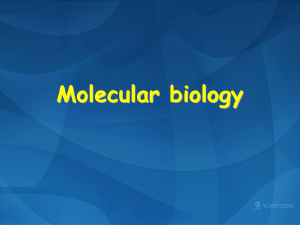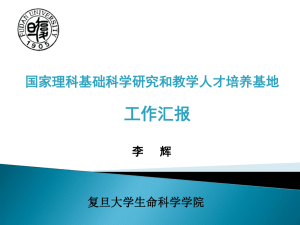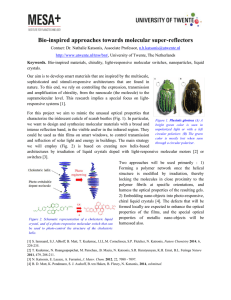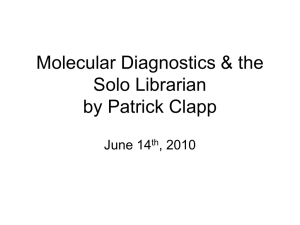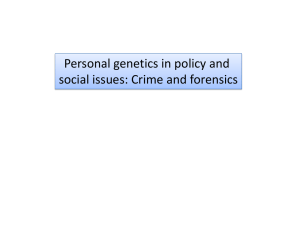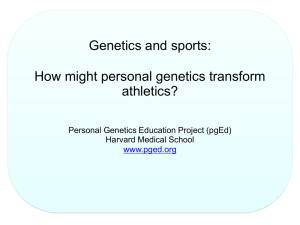Laboratory of Molecular Genetics, KNU
advertisement
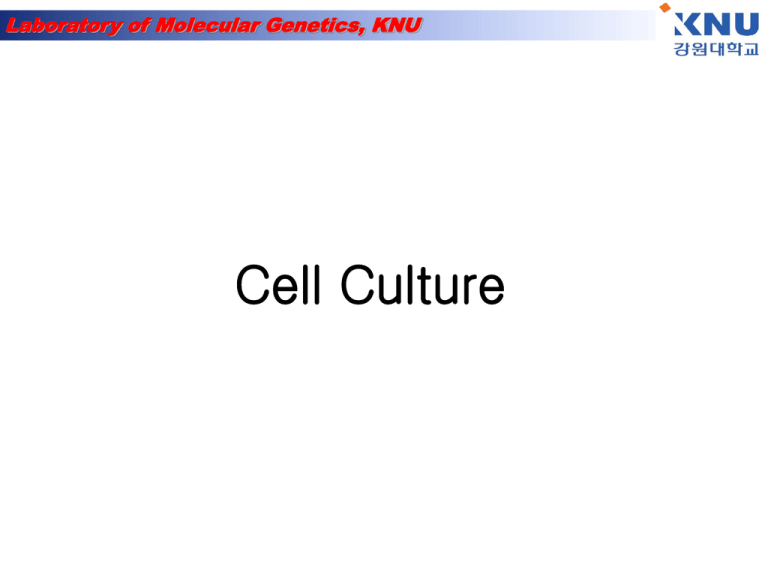
Laboratory of Molecular Genetics, KNU Cell Culture Laboratory of Molecular Genetics, KNU Basics of Cell Culture Laboratory of Molecular Genetics, KNU Introduction • Cell culture is the process by which prokaryo tic, eukaryotic or plant cells are grown under controlled conditions. But in practice it refers to the culturing of cells derived from animal c ells. • Cell culture was first successfully undertaken by Ross Harrison in 1907 • Roux in 1885 for the first time maintained em bryonic chick cells in a cell culture Laboratory of Molecular Genetics, KNU Major development’s in cell culture technology • First development was the use of antibi otics which inhibits the growth of conta minants. • Second was the use of trypsin to remov e adherent cells to subculture further fro m the culture vessel • Third was the use of chemically defined culture medium. Laboratory of Molecular Genetics, KNU Why is cell culture used for? Areas where cell culture technology is curr ently playing a major role. • Model systems for Studying basic cell biology, interactions between di sease causing agents and cells, effects of drugs on cells, pr ocess and triggering of aging & nutritional studies • Toxicity testing Study the effects of new drugs • Cancer research Study the function of various chemicals, virus & r adiation to convert normal cultured cells to cancerous cells Laboratory of Molecular Genetics, KNU Contd…. • Virology Cultivation of virus for vaccine production, also used to study there infectious cycle. • Genetic Engineering Production of commercial proteins, large scale production of viruses for use in vaccine pr oduction e.g. polio, rabies, chicken pox, hepatitis B & measles • Gene therapy Cells having a functional gene can be repl aced to cells which are having non-functional gene Laboratory of Molecular Genetics, KNU Culture media • Choice of media depends on the type of cell being c ultured • Commonly used Medium a re GMEM, EMEM,DMEM et c. • Media is supplemented wit h antibiotics viz. penicillin, streptomycin etc. • Prepared media is filtered and incubated at 4 C Laboratory of Molecular Genetics, KNU Basic equipments used in cell culture • • • • • Laminar cabinet-Vertical are pre ferable Incubation facilities- Temperatur e of 25-30 C for insect & 37 C f or mammalian cells, co2 2-5% & 95% air at 99% relative humidi ty. To prevent cell death incubat ors set to cut out at approx. 38. 5C Refrigerators- Liquid media kept at 4 C, enzymes (e.g. trypsin) & media components (e.g. glutami ne & serum) at -20 C Microscope- An inverted micros cope with 10x to 100x magnifica tion Tissue culture ware- Culture pla stic ware treated by polystyrene Laboratory of Molecular Genetics, KNU Basic aseptic conditions • If working on the bench use a Bunsen flame to heat t he air surrounding the Bunsen • Swab all bottle tops & necks with 70% ethanol • Flame all bottle necks & pipette by passing very quick ly through the hottest part of the flame • Avoiding placing caps & pipettes down on the bench; practice holding bottle tops with the little finger • Work either left to right or vice versa, so that all mater ial goes to one side, once finished • Clean up spills immediately & always leave the work p lace neat & tidy Laboratory of Molecular Genetics, KNU Working with cryopreserved cells • • • • • Vial from liquid nitrogen is plac ed into 37 C water bath, agitate vial continuously until medium i s thawed Centrifuge the vial for 10 mts at 1000 rpm at RT, wipe top of via l with 70% ethanol and discard the supernatant Resuspend the cell pellet in 1 ml of complete medium with 20 % FBS and transfer to properly labeled culture plate containing the appropriate amount of medi um Check the cultures after 24 hrs to ensure that they are attache d to the plate Change medium as the colour changes, use 20% FBS until th e cells are established Laboratory of Molecular Genetics, KNU Freezing cells for storage • Remove the growth medium, wash the cells by PB S and remove the PBS by aspiration • Dislodge the cells by trypsin-versene • Dilute the cells with growth medium • Transfer the cell suspension to a 15 ml conical tub e, centrifuge at 200g for 5 mts at RT and remove t he growth medium by aspiration • Resuspend the cells in 1-2ml of freezing medium • Transfer the cells to cryovials, incubate the cryovi als at -80 C overnight • Next day transfer the cryovials to Liquid nitrogen Laboratory of Molecular Genetics, KNU Culturing of cells • Cells are cultured as anchorage dependent or independent • Cell lines derived from normal ti ssues are considered as anchor age-dependent grows only on a suitable substrate e.g. tissue cel ls • Suspension cells are anchorage -independent e.g. blood cells • Transformed cell lines either gro ws as monolayer or as suspensi on Laboratory of Molecular Genetics, KNU Adherent cells • • • • • • • • • Cells which are anchorage dependent Cells are washed with PBS (free of ca & mg ) solution. Add enough trypsin/EDTA to cover the mon olayer Incubate the plate at 37 C for 1-2 mts Tap the vessel from the sides to dislodge th e cells Add complete medium to dissociate and disl odge the cells with the help of pipette which are remained t o be adherent Add complete medium depends on the subc ulture requirement either to 75 cm or 175 cm flask Laboratory of Molecular Genetics, KNU Suspension cells • • • • Easier to passage as no need to detach them As the suspension cells reach to confluency Asceptically remove 1/3rd of medium Replaced with the same amount of pre-warmed medi um Laboratory of Molecular Genetics, KNU Common cell lines • • • • • • • • • Human cell lines -MCF-7 breast cancer HL 60 Leukemia HEK-293 Human embryonic kidney HeLa Henrietta lacks Primate cell lines Vero African green monkey kidney epithelial cells Cos-7 African green monkey kidney cells And others such as CHO from hamster, sf9 & sf21 from insect c ells Laboratory of Molecular Genetics, KNU Contaminant’s of cell culture Cell culture contaminants of two types • Chemical-difficult to detect caused by endotoxins, plast icizers, metal ions or traces of disinfectants that are invi sible • Biological-cause visible effe cts on the culture they are mycoplasma, yeast, bacteri a or fungus or also from cro ss-contamination of cells fr om other cell lines Laboratory of Molecular Genetics, KNU Cell viability • Cell viability is determined by staining the cells w ith trypan blue • As trypan blue dye is permeable to non-viable c ells or death cells whereas it is impermeable to t his dye • Stain the cells with trypan dye and load to haem ocytometer and calculate % of viable cells - % of viable cells= Nu. of unstained cells x 100 total nu. of cells Laboratory of Molecular Genetics, KNU Cell toxicity • Cytotoxicity causes inhibition of cell growth • Observed effect on the morphological alteration in the cell layer or cell shape • Characteristics of abnormal morphology is the gia nt cells, multinucleated cells, a granular bumpy a ppearance, vacuoles in the cytoplasm or nucleus • Cytotoxicity is determined by substituting material s such as medium, serum, supplements flasks etc . at atime Laboratory of Molecular Genetics, KNU Transfection methods • • • • • • Calcium phosphate precipitation DEAE-dextran (dimethylaminoethyl-dextran) Lipid mediated lipofection Electroporation Retroviral Infection Microinjection Transfection of eukaryotic cells Transfection What is Transfection? Transfection is a method of transporting DNA, RNA and/or various macromolecules into an eukaryotic cell by using chemical, lipid or physical based methods. Methods: (just a few examples…) Method CaPO4, DEAE Liposome Based Polyamine Based Application DNA Transfection DNA Transfection DNA Transfection Early Years • Transfection = “transformation” + “infection” • The infection of cells by the isolated nucleic acid from a virus, resulting in the production of a complete virus 1928: Frederick Griffith transforms Streptococcus pneumoniae 1944: Avery, Macleod and McCarty discover DNA is the transforming factor 1964: Foldes and Trautner use the term transfection 1965: Vaheri and Pagano describe the DEAE-Dextran transfection technique Transfection vs. Transformation Transformation: genetically altering cells by transporting in foreign genetic material. Transfection: the process of transporting genetic material and/or macromolecules into eukaryotic cells through typically non-viral methods. Purpose/uses of Transfection Study gene function Study protein expression Transfer DNA into embryonic stem cells How it works Utilize Chemical, lipid or physical methods (direct microinjection, electroporation, biolistic particle delivery) for transportation of genetic materials or macromolecules. Transfection method 1: DEAEDextran • Facilitates DNA binding to cell membranes and entry via endocytosis • DEAE-D associates with DNAcomplex binds to cell surface Add chloroquine to transfection medium Add plasmid DNA to DEAE-Dextran medium Incubate cells with mixture…efficient transfection results in 25-75% death DMSO “shock” Transfection method 1: DEAEDextran • Major variants: number of cells, concentration of DNA and concentration of DEAE-Dextran • Only method that cannot be used for stable transfections Transfection method 3: liposomemediated • Use of cationic lipids – chemical and physical similarities to biological lipids – spontaneous formation of complexes with DNA, called lipoplexes • • • • High efficiency for in vitro transfections Can carry larger DNA than viruses Safer than viruses Low in vivo efficiency http://homepage.usask.ca/~sdw132/images/lipid_nanoparticle.gif How it works – Chemical and lipid methods Neutralize negative charges on DNA Chemical method: Calcium phosphate; creates precipitates that settle on cells and are taken in. Lipid or Polymer methods: interact with DNA, promotes binding to cells and uptake via endocytosis. Experimental method/process (chemical methods) HBS = HEPES-Buffered Saline Transfection method 2: electroporation • Use of high-voltage electric shocks to introduce DNA into cells • Cell membranes: electrical capacitors unable to pass current • Voltage results in temporary breakdown and formation of pores Harvest cells and resuspend in electroporation buffer Add DNA to cell suspension…for stable transfection DNA should be linearized, for transient the DNA may be supercoiled electroporate Selection process for transfectant Transfection method 2: electroporation • Variants: amplitude and length of electric pulse • Less affected by DNA concentration-linear correlation between amount of DNA present and amount taken up • Can be used for stable transfections How it works – Physical methods Electroporation: use of high voltage to deliver nucleic acids; pores are formed on cell membrane. Direct Microinjection: Use of a fine needle. Has been used for transfer of DNA into embryonic stem cells. Biolistic Particle delivery: Uses high-velocity for delivery of nucleic acids and penetration of cell wall. Advantages/Disadvantages Advantages: Provides the ability to transfer in negatively charged molecules into cells with a negatively charged membrane. Liposome-mediated transport of DNA has high efficiency. Good for longterm studies requiring incorporation of genetic material into the chromosome. Disadvantages: Chemical Reagents: not useful for long-term studies. Transfection efficiency is dependent on cell health, DNA quality, DNA quantity, confluency (40-80%) Direct Microinjection and Biolistic Particle delivery is an expensive and at times a difficult method. Laboratory of Molecular Genetics, KNU Exploring protein function 1) Where is it localized in the cell? Approaches: a) Make antibodies - immunofluorescence b) “Express” the protein in cells with a tag Fuse to GFP 2) What is it doing in the cell? Approaches: a) Reduce protein levels - RNA interference b) Increase protein levels “over-express” c) “Express” mutant versions Transfection!!!! Laboratory of Molecular Genetics, KNU Transfection = Introduction of DNA into mammalian cells Gene is transcribed and translated into protein = “expressed” Laboratory of Molecular Genetics, KNU Direct introduction of the DNA Electroporation - electric field temporarily disrupts plasma membrane Biolistics (gene gun)- fire DNA coated particles into cell Microinjection Laboratory of Molecular Genetics, KNU Virally-mediated introduction of the DNA Infection: Use recombinant viruses to deliver DNA Retroviruses Adenoviruses Laboratory of Molecular Genetics, KNU Carrier-mediated introduction of the DNA Positively charged carrier molecules are mixed with the DNA and added to cell culture media: Calcium Phosphate DEAE Dextran liposomes micelles Carrier-DNA complexes bind to plasma membrane and are taken up Laboratory of Molecular Genetics, KNU Types of Transfection Transient: Expression assayed 24-48 hours post transfection Stable: Integration of the transfected DNA into the cell genome - selectable marker like neomycin resistance required “stably transfected” cell line Laboratory of Molecular Genetics, KNU DNA “expression” vector transfected: For expression in cells Insert gene in here Polyadenylation site To generate stable cell line pCMV/GFP For amplification of the plasmid in bacteria pUC Polyadenylation site Bacterial origin of replication Laboratory of Molecular Genetics, KNU Three ways to make Green fluorescent protein “GFP” fusion constructs: PROTEIN X GFP PROTEIN GFP PROTEIN Y GFP Z Laboratory of Molecular Genetics, KNU EXPERIMENT: Transfect unknown GFP fusion protein Protein X, Y or Z Visualize GFP protein fluorescence by fluorescence microscopy in living cells Counter-stain with known marker to compare localization patterns in living cells = “vital stain” Laboratory of Molecular Genetics, KNU Some Cellular Organelles Laboratory of Molecular Genetics, KNU •Compartments/organelles examined •Protein sequences sufficient for localization •Vital stains Nuclei Mitochondria Secretory Pathway: Endoplasmic Reticulum Golgi Complex Endocytotic Pathway: Endosomes Laboratory of Molecular Genetics, KNU Nucleus Transport through nuclear pore signal = basic amino acid stretches example: P-P-K-K-K-R-K-V Laboratory of Molecular Genetics, KNU Import of proteins into nucleus through nuclear pore Laboratory of Molecular Genetics, KNU Nuclear Stain: Hoechst 33258 binds DNA Laboratory of Molecular Genetics, KNU Mitochondria Transmembrane transport signal Example: H2N-M-L-S-L-R-Q-S-I-R-F-F-KP-A-A-T-R-T-L-C-S-S-R-Y-L-L Laboratory of Molecular Genetics, KNU Protein being transported across mitochondrial membranes Laboratory of Molecular Genetics, KNU Mitochondrial dye = MitoTracker Red Diffuses through membranes Non-fluorescent until oxidized Accumulates in mitochondria and oxidized Mitotracker DNA Laboratory of Molecular Genetics, KNU Cellular components of the secretory and endocytic pathways lysosome plasma membrane late endosome nuclear envelope endoplasmic reticulum early endosome CYTOSOL cis Golgi network Golgi stack trans Golgi network Golgi apparatus Laboratory of Molecular Genetics, KNU Endoplasmic Reticulum Entry into E.R.: Transmembrane transport signal = hydrophobic amino acid stretches at amino terminus Example: H2N-M-M-S-F-V-S-L-L-V-G-I-LF-W-A-T-E-A-E-Q-L-T-K-C-E-V-F-Q Retention in E.R. lumen: Signal = K-D-E-L-COOH at carboxy terminus Laboratory of Molecular Genetics, KNU Endoplasmic Reticulum marker ER-Tracker Blue-White Live bovine pulmonary artery endothelial cells Laboratory of Molecular Genetics, KNU Mitotracker Red and ERblue/white Laboratory of Molecular Genetics, KNU nucleus Golgi From the ER, secreted and membrane proteins move to the Golgi, a series of membrane-bound compartments found near the nucleus Laboratory of Molecular Genetics, KNU Golgi marker BODIPY-TR ceramide Ceramide = lipid When metabolized, concentrates in the Golgi Red fluorophore Laboratory of Molecular Genetics, KNU Cultured Epithelial Cells DNA (Hoechst) Golgi (ceramide) Laboratory of Molecular Genetics, KNU MDCK Cells Madin-Darby Canine Kidney Polarized Epithelial Cells DNA (Hoechst) Golgi (ceramide) Lysosomes (LysoTracker) Molecular Probes, Inc. Laboratory of Molecular Genetics, KNU Rhodamine transferrin Does the fluorescent green protein co-localize? Laboratory of Molecular Genetics, KNU Immunofluorescence / confocal microscopy 원리 Laboratory of Molecular Genetics, KNU Immunofluorescence / confocal microscopy 실험방법 Immunofluorescence / confocal microscopy B or T cells in suspension, adherent cells on chambered coverglass or chamberslides, cryostat sections of unfixed, OCT embedded tissue: 1. wash cells 1x cold RPMI (no wash for cryostat sections). 2. Fix 20 min 4% paraformaldehyde in 0.1M phosphate buffer pH 7.4, 0.03M sucrose on ice. ** 3. wash 2x PBS/1%BSA. From now on everything can be at room temp. or on ice. 4. Permeabilize 5 min RT in 0.2% saponin, PBS, 0.03M sucrose, 1% BSA. 5. wash 1x PBS/BSA. 6. Block 15 min 5% normal goat serum (NGS) in PBS/BSA. 7. wash 1x PBS/BSA. 8. 1° diluted in PBS/BSA 60 min RT; 100 l per tube or section. 9. wash 3x PBS/BSA. 10. Block 15 min 5% NGS in PBS/BSA. 11. wash 1x PBS/BSA. 12. 2° diluted in PBS/BSA 30 min RT; 100 l per tube or section. 13. wash 3x PBS/BSA; (wash 1x in PBS/BSA then 2 x 10 min in Molecular Probes SlowFade Light buffer if using Slow Fade Light S-7461 to coversip); pellet cells and put up in two drops of Molecular Probes Slowfade Light antifade medium. Pipet about 15 m l on slide and coverslip. For chambered coverglass just put two-three drops in each chamber after wash. High-throughput loss-of-function screens using RNAi cell microarrays. An example of a high-density, high-content RNAi cell-microarray screen in cultured D. melanogaster Kc167 cells. Laboratory of Molecular Genetics, KNU Experimental Animals Laboratory of Molecular Genetics, KNU Model systems E. coli - easy and inexpensive to maintain - 사람 장내 서식, 배설물의 주성분 - 해로운 박테리아의 생장 저해 Pathogenic은 sickness, death 유발 - 돌연변이 잘 유발 → Metabolism 연구에 이용 Eukaryote에서의 과정 일어나지 않음 Laboratory of Molecular Genetics, KNU • Yeast - Eukaryote와 prokaryote 사이의 차이점 연구에 이용 - Genetic study easy - haploid, single-celled - Grow very rapidly, inexpensive - 2가지 종류 사용 → Saccaromyces cerevisiae; budding → Schizosaccaromyces pombe; fission Laboratory of Molecular Genetics, KNU Cloning the yeast origin of replication - yeast genome cut restriction enzyme - fragments clone into plasmid vector - recombinant plasmids growth and select - yeast survive in media lacking leucine - selected yeast cells contain leu2+ gene Laboratory of Molecular Genetics, KNU Nematoda worm - Small and easy to keep - Three days to develop Multicellular organism Caenorhabditis elegans Fruit fly Identification of mutant → mutation 특징 확인이 쉬움 - 짧은 시간에 많은 자손 생산 - 알에서 성체가 되기까지 12일 소요 - Drosophila melanogaster Laboratory of Molecular Genetics, KNU Zebrafish - Reproduction rapidly and high number - vertebrate - 발생 과정이 사람과 유사 - 알이 투명하여 발달 확인 가능 Danio rerio Amphibians - 알의 크기가 큼 →발생학 연구에 이용 - 1920년 슈페만 형성체 발견 - Xenopus leavis Laboratory of Molecular Genetics, KNU Chicken 배 발생 연구에서 알 사용됨 ; 진화상 인간과 유사 - 알이 크고, 분화 관찰에 좋음 - Gallus gallus Mouse - vertebrate, mammals Human과 더욱 가까움 ; 생리학, 발생학적으로 유사 - Expensive to maintain, Reproduce slowly Knock out mouse 이용 → 특정 gene의 기능 확인 Laboratory of Molecular Genetics, KNU Human cell culture Human blood나 tissue에서 분리 Primary culture ; derived directly from living tissue - Grow for a short period time and stop - 세포 분열 횟수 제한 Plants - Grow slowly, long generation time - 세포벽 때문에 형질전환이 어려움 - Large genome - Transposon 연구에 이용 ; corn - Arabidopsis thaliana

